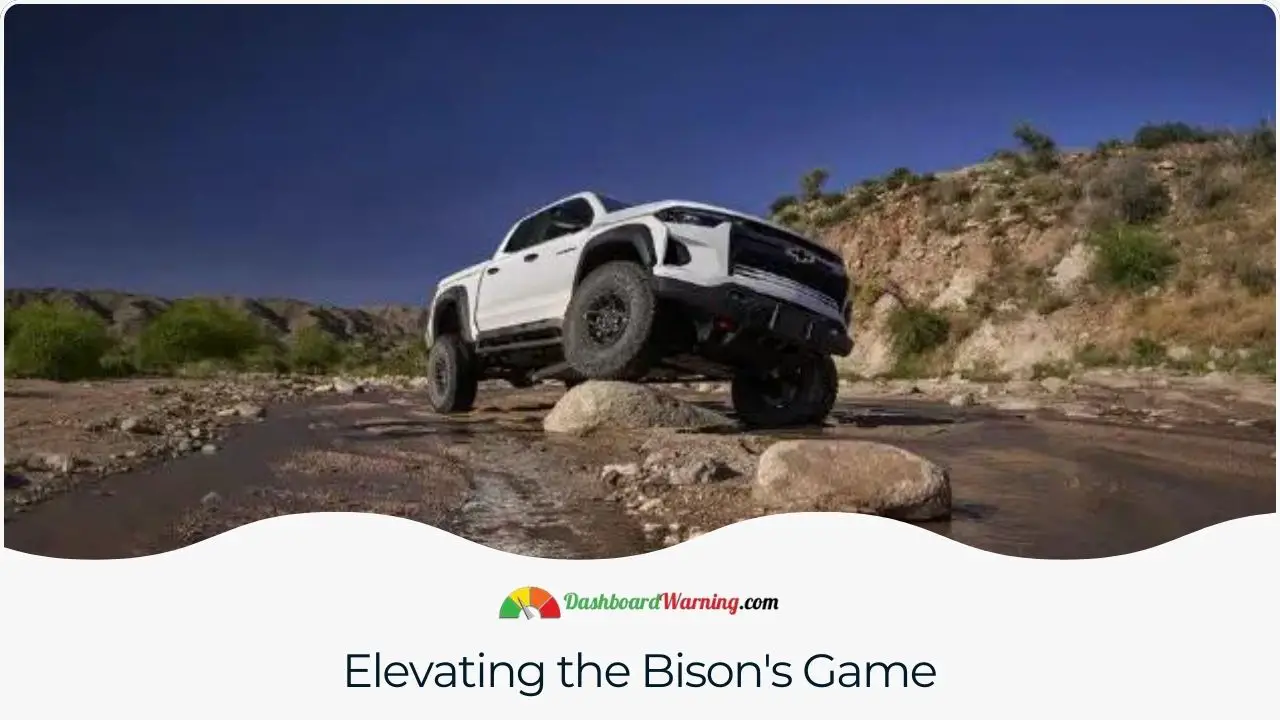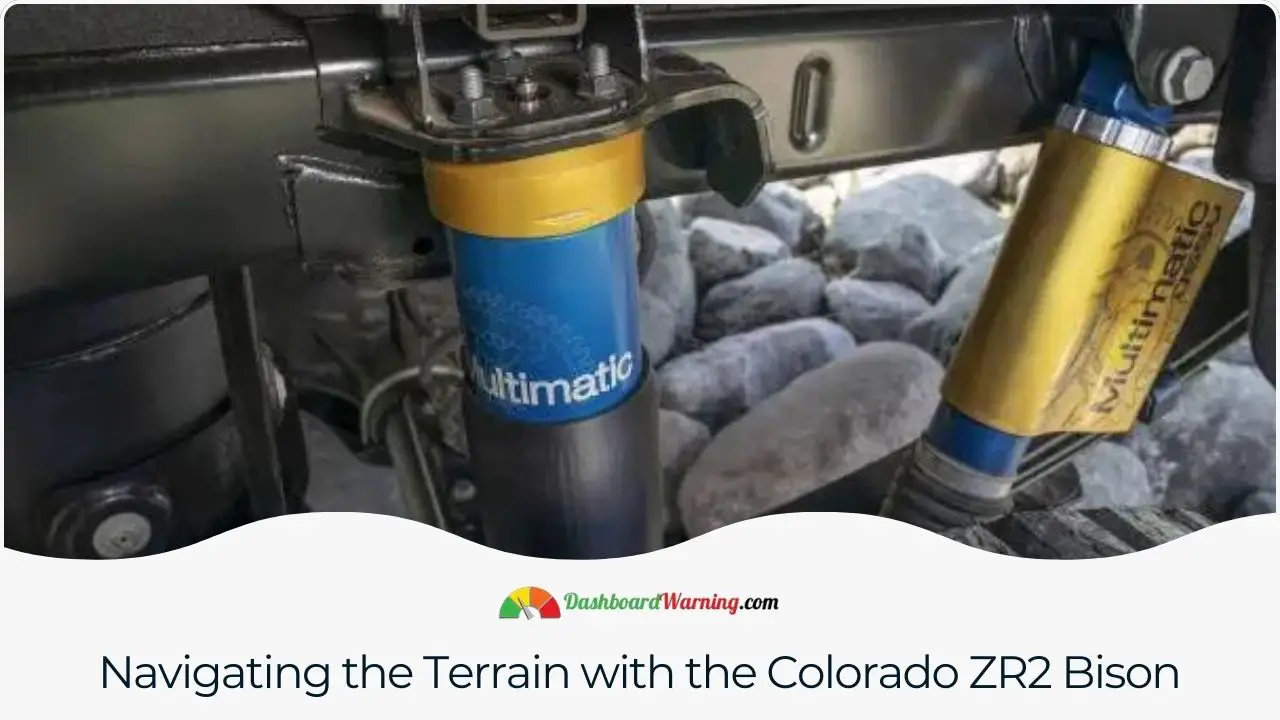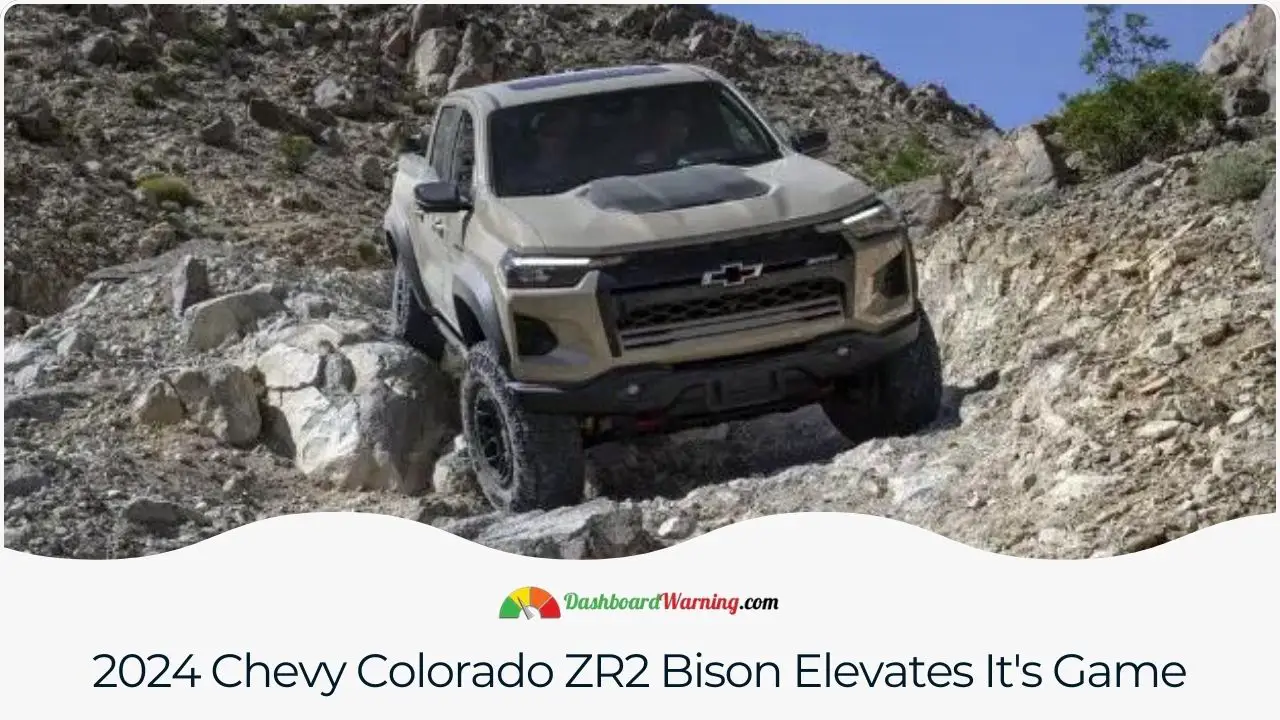One might be tempted to dismiss the 2024 Chevy Colorado ZR2 Bison as just another ZR2 adorned with unique AEV wheels, reinforced AEV bumpers at both ends, a collection of boron-steel skidplates, and a smattering of AEV insignias. And honestly, who could blame them? After all, this was the blueprint for the inaugural Colorado ZR2, a pattern echoed in the Silverado 1500 ZR2 and 2500HD ZR2. The common thread? The ZR2 modifications were outside the original plans when these trucks first saw the drawing board.
However, the narrative shifts with the Colorado ZR2's sophomore iteration. Crafted after the ZR2's soaring popularity, it paved the way for more radical alterations. This was evident during our exhilarating three-day journey across Nevada's vast desert. Notable changes included the front axle's relocation, moving it forward about the cab to make room for heftier tires. The iconic Multimatic DSSV shocks also found their rightful place outside the leaf springs. These modifications didn't merely enhance the Colorado ZR2's prowess; they set the stage for an even more formidable ZR2 Bison.
👀Look at this: 2024 Kia Forte Interior and Exterior, Safety and Price
2024 Chevy Colorado ZR2 Bison: Elevating the Bison's Game

The colossal 35-inch tires, a step up from the ZR2's already impressive 33-inch ones, underscored the forward shift of the front axle, a move made with the Bison variant in mind. But housing these giants required more. Chevy reimagined the fender liners and raised the suspension by half an inch. This elevation and the added tire radius boosts ground clearance from a respectable 10.7 inches to a whopping 12.2 inches. The Bison's LT315 tires also have an added circumference of 1.2 inches. To prevent internal friction, the 17-by-8.5-inch wheels' offset was nudged nearly half an inch outward. Marrying these details results in a broader track by 0.9 inches and an increase in the outer sidewall width by approximately 2.1 inches. As a result, the ZR2 Bison sports pronounced fender flares, stretching its width to 80.1 inches, a full 2.0 inches more than the ZR2, lending it a more aggressive posture.
Behind these tires is a feature exclusive to the Colorado Bison: hydraulic jounce bumpers, or as enthusiasts might dub them, the "ultimate bump stops," present at every corner. These are the brainchild of Multimatic, the same genius behind the ZR2's spool-valve dampers. A shock return is the go-to when beefier tires are introduced. However, these hydraulic jounce bumpers usher in innovations that render this step imperative. They present an added layer of dedicated compression damping, necessitating harmonization between the two components. While the Bison's Multimatics don't extend the overall suspension travel, they ensure it doesn't diminish either. Their equilibrium was recalibrated to maintain the balance between compression and rebound.
👀Look at this: 2024 infiniti q50 Features, Price, and Release Date

Racing through the undulating dunes of the vast California desert, the ZR2 Bison truly showcases its mettle. The ability to maintain higher speeds even in challenging terrains was evident, and the vehicle devoured them with an insatiable appetite. Granted, the absence of added travel set boundaries on how much we could push the envelope. However, the hydraulic jounce bumpers flawlessly executed landings, absorbing significant impacts with a smoothness that was hard to ignore. A minor hiccup, if one could even call it that, was the faint sound produced when the front bumpers made contact with the lower control arms, a standard occurrence on particularly rugged terrains.
The Bison's prowess in rockier terrain was undeniable. The added ground clearance proved invaluable, especially when navigating trails littered with sharp, massive rocks reminiscent of every Yeti product. The rock rails bore some scratches, but that's their job. The same goes for the five boron-steel skidplates that shield the vehicle's undercarriage and differential. The front and rear AEV bumpers are meticulously designed, though the rear could benefit from enhanced lower bedside protection, akin to what one sees on the Jeep Gladiator.
🚨You may be interested in: 2024 GMC Acadia Features, Price, and Release Date
As is often the case with larger tires, the 35s effortlessly navigated terrains that might have hindered smaller tires. The default front and rear lockers were always on standby, but the threshold for their activation was significantly higher. If there were ever a need to reduce tire pressure drastically, the Bison's standard 17-inch AEV beadlock-ready wheels would have facilitated even further deflation, assuming the accessory beadlock rings were in place. The spare tire, identical in size, finds its place vertically in the truck bed due to space constraints, reducing bed space but enhancing the departure angle compared to the ZR2.
While initially excited about the Terrain mode's one-pedal crawling feature, further exposure to rocky terrains dampened our enthusiasm. This mode proved a tad jerky in landscapes where stability is paramount, and the ground beneath is unpredictable. The key lies in maintaining foot steadiness, especially when a sensitive throttle controls the brakes. The Off-Road mode seems more apt for rock crawling, reserving the Terrain mode for less challenging terrains like sandy paths or Moab Slickrock.
When the path ahead is clear, Baja mode remains the top choice, with its relaxed stability control that can be easily toggled via the touchscreen. However, the larger tires, without a corresponding gear ratio adjustment, make the Bison feel less energetic than the regular ZR2. A 3.73:1 gear ratio, instead of the standard 3.42:1, might have added that missing zest. Towing capacity is likely at most 5500 pounds (compared to the ZR2's 6000 pounds), primarily due to the Bison's additional weight, roughly 300 pounds more than the regular ZR2.
Could the Bison match the ZR2's EPA fuel economy rating of 18 mpg combined (17 city/19 highway)? Given the Bison's added heft and the aerodynamic challenges posed by a broader vehicle with larger tires, a 1-mpg drop across all metrics seems plausible.
The True Worth of the Colorado ZR2 Bison

The real problem is the price tag. One can only speculate with the 2024 Colorado's pricing still under wraps. The 2023 Colorado ZR2 was priced at $48,295, and the previous ZR2 Bison variant, sans the 35-inch tires and advanced jounce bumpers, came with a $5750 tag. Given the upgrades, a heftier price is inevitable. If the 2024 Colorado ZR2 starts at $49,500 and the enhanced Bison package adds another $7500, the total comes to an estimated $57,000. It's a steep price for a mid-sized truck, but after our experience, the 2024 Chevy Colorado ZR2 Bison's enhanced capabilities and rugged aesthetics make it a worthy investment.
Was this page helpful?


More important content about Chevrolet
DTC C0561-71 Traction Control Code on GMC and Chevy
2023 Chevy Silverado 2500 Test Drive And Price
Chevy Battery Warning Light On: How to Turn Off?
Which C5 Corvette Years To Avoid: Expert Insights
P1e00 Chevy Volt | Hybrid Powertrain Control Module 2 Requested MIL Illumination
Tips and Advice
Porsche Cayenne Years To Avoid
Subaru Legacy Years To Avoid - 5 Worst Years
Pt Cruiser Years To Avoid
Use 5w30 instead of 0w20 - Advantages and Disadvantages
Tractor Dashboard Symbols And Meanings
Suzuki Sx4 Years To Avoid - 5 Worst Years